Texas Instruments
LM25115AMTX/NOPB
LM25115AMTX/NOPB
Couldn't load pickup availability
LM25115AMTX/NOPB Texas Instruments - Yeehing Electronics
42V, Secondary Side Post Regulator/Synchronous Buck Controller with Power-Up/Power-Down Tracking
Pricing (USD)
| Quantity | Unit Price |
| 1 — 99 | 2.151 |
| 100 — 249 | 1.885 |
| 250 — 999 | 1.322 |
| 1,000 + | 0.75 |
The above prices are for reference only.
Specifications
| Manufacturer | Texas Instruments |
| Product Category | Switching Controllers |
| RoHS | Y |
| Topology | Synchronous Secondary Side Post Regulator |
| Number of Outputs | 1 Output |
| Switching Frequency | 50 kHz to 1000 kHz |
| Input Voltage | 4.5 V to 30 V |
| Output Voltage | 0.75 V to 13.5 V |
| Output Current | 2.5 A |
| Minimum Operating Temperature | - 40 C |
| Maximum Operating Temperature | + 125 C |
| Mounting Style | SMD/SMT |
| Package / Case | TSSOP-16 |
| Packaging | Reel |
| Operating Temperature Range | - 40 C to + 125 C |
| Series | LM25115A |
| Type | Synchronous Buck Controller |
| Brand | Texas Instruments |
| Product Type | Switching Controllers |
| Factory Pack Quantity | 2500 |
| Subcategory | PMIC - Power Management ICs |
| Unit Weight | 0.006102 oz |
For more information, please refer to datasheet
Documents
| LM25115AMTX/NOPB Datasheet |
More Information
The LM25115A controller contains all of the features necessary to produce multiple tracking outputs using the Secondary Side Post Regulation (SSPR) technique. The SSPR technique develops a highly efficient and well regulated auxiliary output from the secondary side switching waveform of an isolated power converter. LM25115A can be also used as a standalone DC/DC synchronous buck controller (Refer to section). Regulation of the auxiliary output voltage is achieved by leading edge pulse width modulation (PWM) of the main channel duty cycle. Leading edge modulation is compatible with either current mode or voltage mode control of the main output. The LM25115A drives external high-side and low-side NMOS power switches configured as a synchronous buck regulator. A current sense amplifier provides overload protection and operates over a wide common mode input range. Additional features include a low dropout (LDO) bias regulator, error amplifier, precision reference, adaptive dead time control of the gate signals and thermal shutdown.

